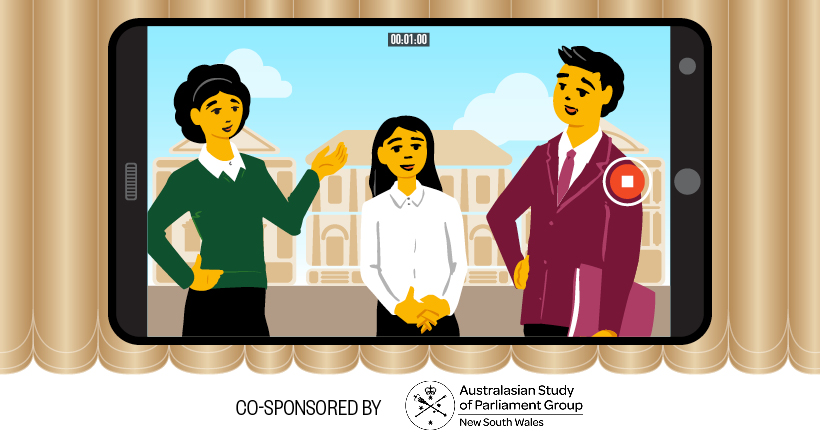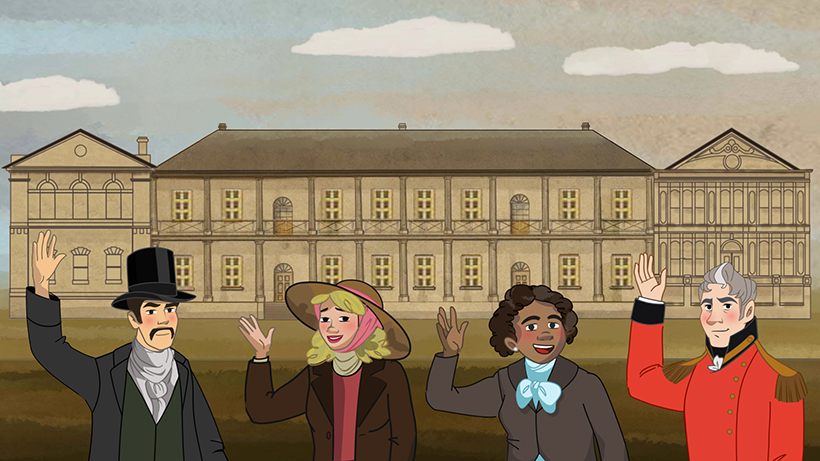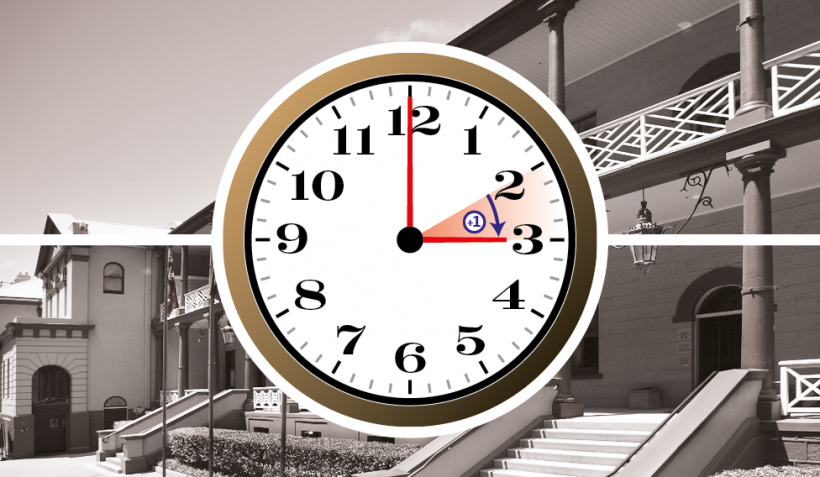Learning Outcomes
- Outline the role and function of the NSW Parliament
- Describe the role of the Legislative Assembly
- Describe the role of the Legislative Council
- Explain the role of a member in parliament and in their electorate
- Outline the main steps in making a law
- Outline the role of parliamentary committees
Syllabus Links
AUSTRALIA AS A NATION
Key figures and events that led to Australia’s Federation, including British and American influences on Australia’s system of law and government (ACHHK113)
- outline local, state and federal government structures and responsibilities.
What is the NSW Parliament?
In a parliamentary democracy the people of a nation or state elect a parliament to make laws.
The New South Wales Parliament is bicameral which means it is made up of two Houses.
- Lower House or Legislative Assembly and the
- Upper House or Legislative Council.
This means a bill has to be reviewed and passed by both houses before it can become a law.

Watch: A Sitting Day in the 57th Parliament (2019 - 2023)
Stay tuned for an updated video with the Speaker of the 58th Parliament The Hon. Greg Piper MP.
What Does the Legislative Assembly Do?
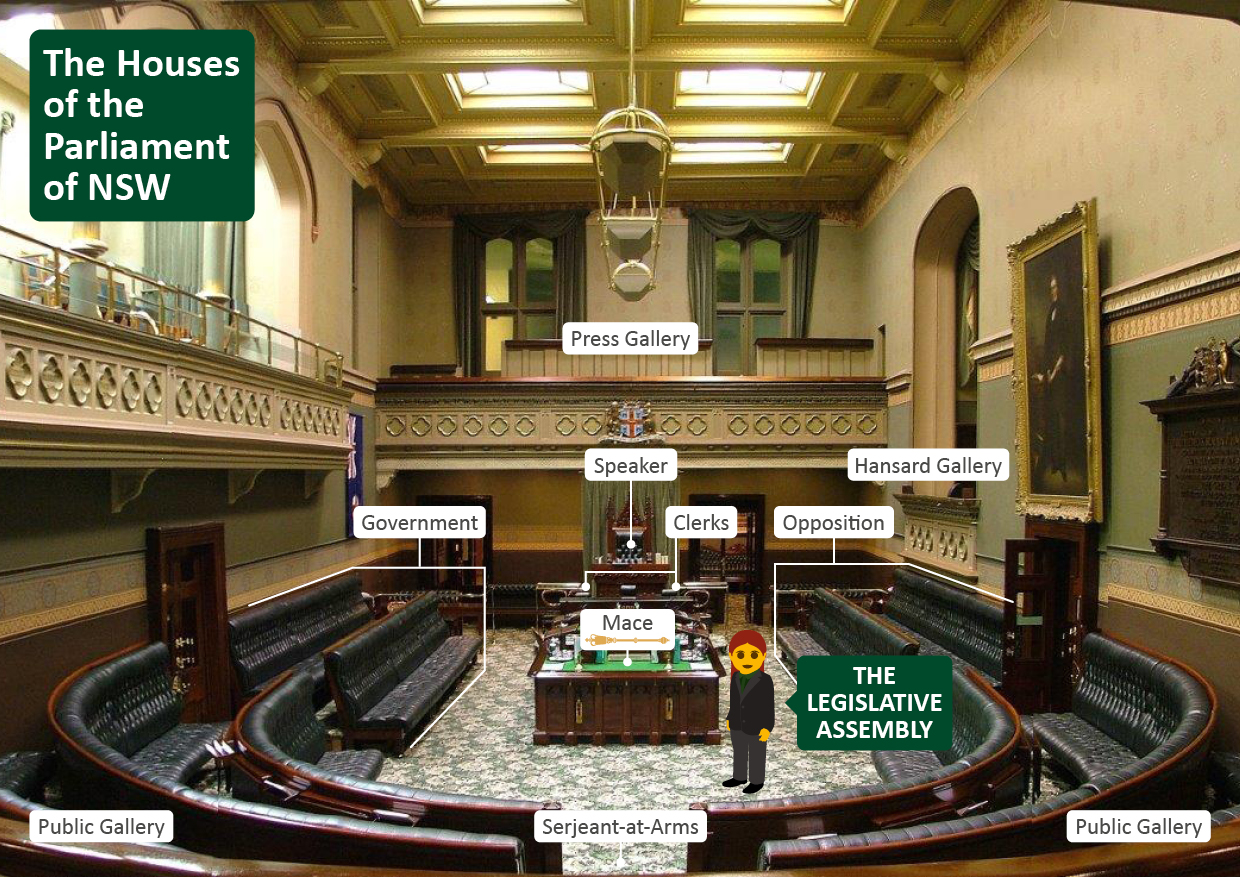
The main roles of Legislative Assembly are:
- To represent the people: There are 93 members of Parliament (MPs), each representing one of the 93 electorates in the State. Elections must be held every 4 years and members of the Legislative Assembly are elected for a 4 year term.
- To form the Government for New South Wales: The leader of the party which commands a majority in the Legislative Assembly after an election is commissioned by the Governor to form a Government and become Premier. The Ministers are Members of Parliament chosen from that party.
- To make laws: The Parliament makes laws by debating bills in each House, which, if agreed to by both Houses, are then sent to the Governor for assent.
- To keep the Government accountable to the people of New South Wales: Members ask questions of Ministers at Question Time, raise concerns or express opinions in parliamentary speeches, participate in parliamentary committees to inquire into issues, present petitions from their constituents to Parliament.
Go on a Virtual Tour of the Legislative Assembly Chamber
What is the Mace?
The Mace was originally a medieval weapon but by 1629 it had become a ceremonial mace in the House of Commons. The ceremonies and traditions associated with the mace, developed over centuries in the British Parliament, have been adopted by all Australian Lower Houses of Parliament.
The Legislative Assembly of New South Wales acquired its Mace in 1974 when it was gifted to the Parliament by the NSW Jewish Board of Deputies. It is 1.5m in length and made of silver with an applied surface of gold. The mace is carried into the Legislative Assembly Chamber by the Sergeant-at-Arms. It is a symbol of the authority of the Speaker and is placed on a rack at the end of the central table, the crown facing the Government benches.

What Does the Legislative Council Do?
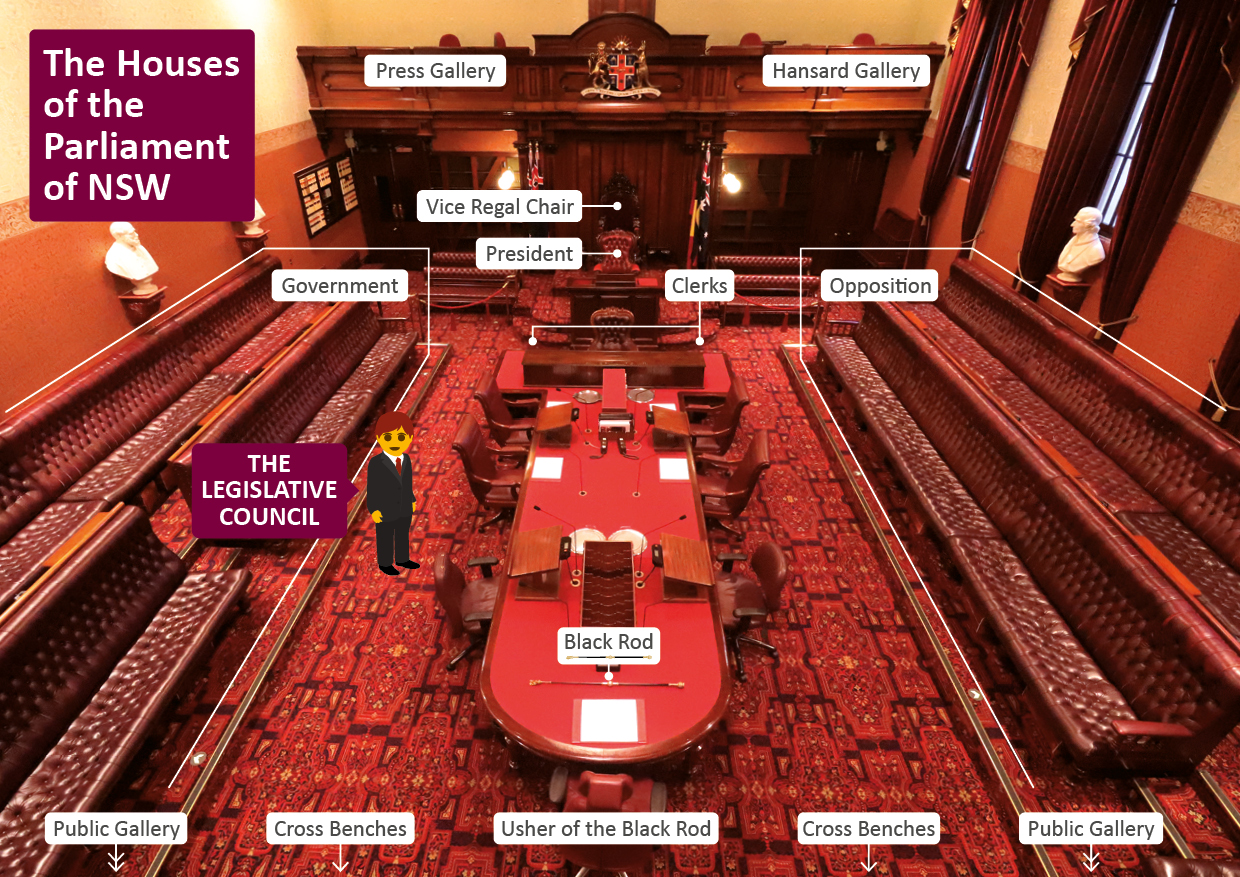
The main roles of the Legislative Council are:
- To represent the people: There are 42 members of the Legislative Council (MLCs) elected for eight years each representing the whole State of New South Wales. Every four years at the State election 21 members are elected.
- To make laws: The two Houses of the New South Wales Parliament have equal power in the making of laws. The Legislative Council can amend or reject any bill sent to it by the Legislative Assembly. Bills can also start in the Upper House. The only exception is money bills which must originate in the Lower House.
- To keep the Government accountable to the people of New South Wales: The Legislative Council is also known as the House of Review. It keeps Government accountable by debating bills; reviewing legislation; inquiring into issues through the committee system, including the annual Budget Estimates inquiries; ordering the Government to table state papers in the House; questioning Ministers at Question Time.
Go on a Virtual Tour of the Legislative Council Chamber
What is the Black Rod?
Many of the symbols, practices and procedures of the New South Wales Parliament derive from those developed over the centuries by the English Parliament. The Black Rod is carried by the Usher of the Black Rod, an officer with important administrative and ceremonial roles in the Legislative Council. Its use can be traced back to 1361 in England.
A Black Rod has been used by the Upper House in New South Wales since 1856 and the current one is the third, having been presented to the Parliament by the Bank of NSW in 1974. It is made from ebony, a very dark, hard wood. On the top of the Black Rod is the coat of arms and holding it up is a gold lion symbolising the historic link with Britain and the Westminster system. It is a symbol of the authority of the Legislative Council and is placed at the end of the central table, the lion facing the Government benches.
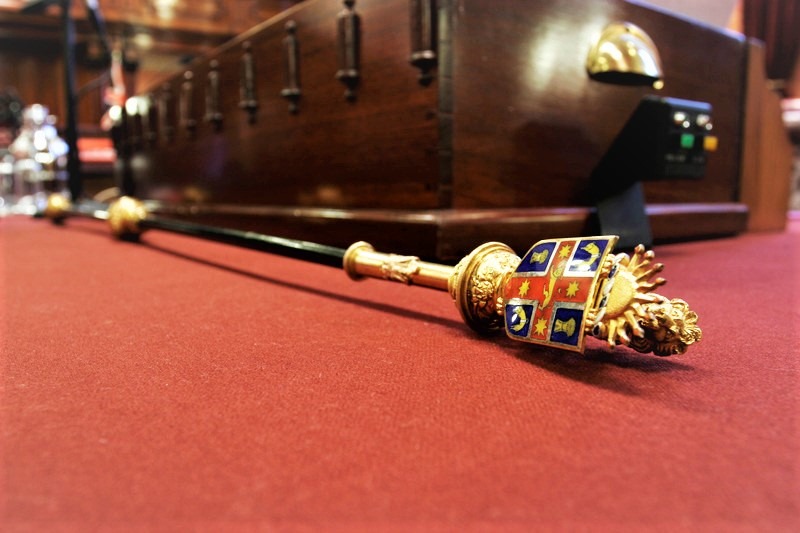
Learn More About the Black Rod
Role of a Member
Members of Parliament have two main roles: representatives and legislators. They work both in parliament and in their electorates.
The Parliament of NSW sits between 40 and 60 days each year in two sessions: the Budget session, which starts in February and ends in June; and the spring session which starts in September and ends in December. (More information about Parliamentary Sitting days and times.)
What Do Members Do In Parliament?
- Contribute to the law-making process by proposing and debating laws
- Vote on Bills that are before the parliament
- Speak on their constituents’ behalf or highlight issues or events from their electorates
- Ask Ministers questions during Question Time or answer questions if they are Ministers
- Attend meetings of the political party they belong to
What Do Members Do In Their Electorates?
● Receive requests for assistance and information from people in their electorate (for example, housing, transport, environment, state taxes, etc). They try to solve these problems or refer them to Ministers or other authorities
● Meet with local organisations, businesses, and government departments to find out their needs and attend local events
● Make representations (speak or write) to Ministers on behalf of local organisations, businesses and individuals
● Monitor, and lobby for, provision of local services and facilities from government funds
● Attend party branch/local supporters meetings
Making the Law
There are two main types of law:
- Statute law is the law made by Parliament. It is introduced in a bill and, if passed, becomes an Act.
- Common Law is made by judges and has been developed through centuries of precedent, or earlier judgements on cases before courts.
Where Do Ideas for Laws Come From?
1. Developing ideas for laws. These are called policies.
2. Drafting a Bill. This is the process of turning an idea or a policy into the precise language of a law and is the work of expert drafters in the office of Parliamentary Counsel.

3. The Parliamentary Process. Many bills are introduced by Ministers in the Legislative Assembly but any member of Parliament can introduce a bill in either House. Money bills are the only exception and can only be introduced in the Legislative Assembly. Bills that are not passed by both Houses may be presented again later, perhaps in a different form or after an election.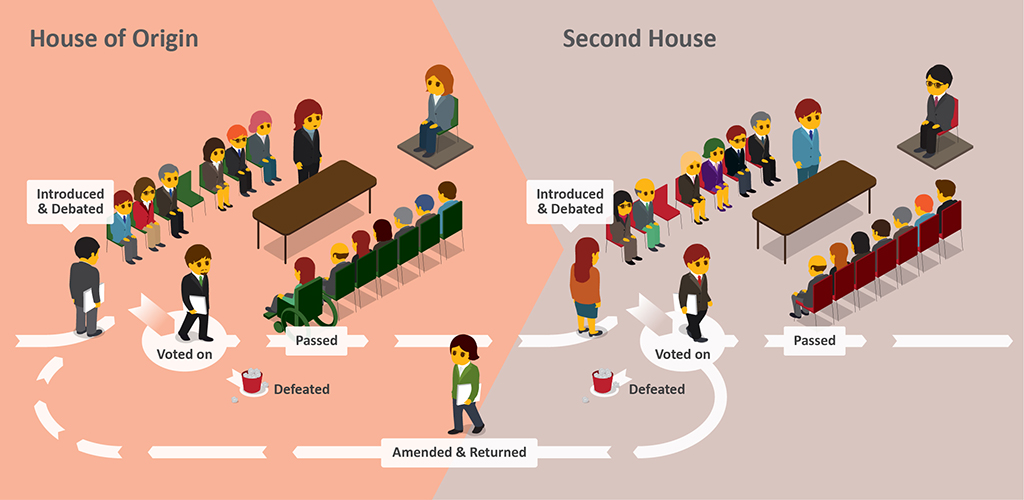
4. Royal
Assent. The final stage in the process by which a Bill becomes an Act. Once it has passed through all stages in both Houses, the Governor signs it to give it formal approval. 5.
Commencement. An Act will come into force 28 days after the Governor’s signature unless the Act specifies otherwise.
5.
Commencement. An Act will come into force 28 days after the Governor’s signature unless the Act specifies otherwise.
What is a regulation?
Regulations are also called delegated legislation. Some Acts of Parliament only outline broad guidelines, leaving details to be defined later in regulations made through a Minister. (e.g: Traffic Act, Health Laws, Planning Laws)
Parliamentary Committees and Members of Parliament

Parliament appoints committees made up of members to inquire into and report back on such things as:
- a proposed new law
- an important or controversial social or legal problem
- a proposed government activity
- the budgets and expenditures of government departments
- the work of particular bodies (e.g. Independent Commission Against Corruption)
- reviewing government regulations
Committees then:
- invite interested people and organisations to put their views to the committee in writing
- hold public hearings to hear about ideas and opinions from the community
- produce a report with recommendations as to what action the government should take
Find out about NSW Parliamentary Committees and their inquiries.




